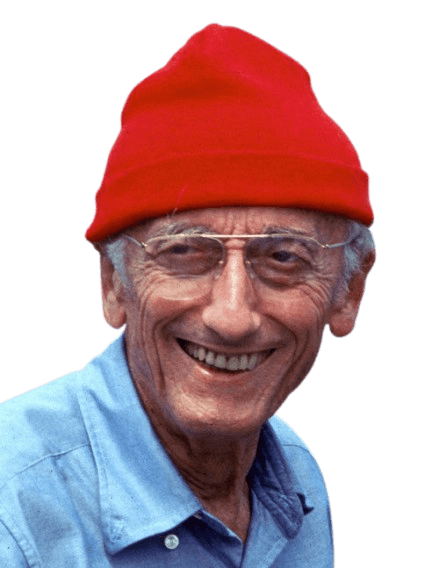Life and achievements
Early life
Jacques Cousteau was born on June 11, 1910, in the small town of Saint-André-de-Cubzac in France. From a very young age, he was curious about technology and the sea, which later defined him as an oceanographer. Exploration was always a part of Cousteau's early years. He was educated at the Collège Stanislas in Paris and, in 1930, joined the French Naval Academy to join the French Air Army. However, a severe car accident slowed these dreams, and he turned to the seas as a new challenge.
This change of direction led Cousteau to his lifelong interest in the sea and underwater exploration. Cousteau worked with the French Navy in the Second World War, where he performed some experiments on the available diving apparatus. Working with engineer Émile Gagnan, he developed the Aqua-Lung, which changed diving by making long underwater expeditions possible. This was the start of Cousteau's journey in the sea and the marine environment.
The first dives off the French coast with the Aqua-Lung enabled Cousteau to capture the marine life firsthand, thus cementing his love for underwater filmmaking and oceanography.
Legacy
Jacques Cousteau was an explorer and an advocate of the environment. His invention of the Aqua-Lung made ocean bottoms available for research and to create awareness of the underwater world among the populace. With documentaries such as The Silent World and The Undersea World of Jacques Cousteau, he changed how people perceived the ocean and brought the unknown world to the living rooms of millions of people.
While using a recently invented device for underwater filming, Cousteau not only recorded the lives of sea creatures but also explained why they needed to be saved.
However, Cousteau's contribution to ocean conservation was not limited to the movies. He was primarily involved in establishing The Cousteau Society in 1973, which aimed to preserve the marine environment. His environmental work, especially his fight against nuclear waste disposal in the Mediterranean Sea, paved the way for the international campaign to maintain oceans.
Today, Cousteau is considered an inspiration for contemporary environmentalism, as his words on overfishing, pollution, and climate change are still valid.
Apart from the environmental conservation efforts, Cousteau has been an educator and a communicator of excellence. His talent for enthralling people with ocean mysteries made him one of the most famous personalities in marine biology. Cousteau paved the way for generations of oceanographers, conservationists, and explorers through his books, documentaries, and speeches.
Today, his work goes on through The Cousteau Society, which exists to this day with the mission of preserving the oceans for future generations.
Milestone moments
Jun 11, 1910
Birth of Jacques Cousteau
Jacques-Yves Cousteau was born in Saint-André-de-Cubzac, France, and he grew up in a family that nurtured his inquisitiveness about nature.
Since his childhood, Cousteau was fond of exploring, which could be observed in his experiments with devices and in nature.
His passion for the sea would only increase in the course of his development, and he would become one of the greatest oceanographers in the world.
It is interesting to note that as a young boy, Cousteau was interested in mechanics and how things worked in this world.
His early exposure to technology, coupled with his curiosity, prepared him for his future invention in underwater exploration.
His parents encouraged him in his academic endeavors, and by the time Cousteau was a grown man, he was utterly obsessed with the ocean.
Jan 18, 1943
Co-Invention of the Aqua-Lung
In 1943, Jacques Cousteau and engineer Émile Gagnan designed the Aqua-Lung, the first successful open-circuit SCUBA diving equipment.
This invention allowed divers to spend more time underwater without having to be connected to a supply of air on the surface.
The Aqua-Lung introduced scientists and explorers to the ocean depths, revolutionizing the field of marine biology.
Therefore, Aqua-Lung's invention significantly shifted Cousteau's career and oceanography in general.
This new technology allowed Cousteau to explore the underwater environment in ways that had not been seen before.
The initial use of the Aqua-Lung made him record some of his first underwater scenes that captured the structural and aesthetic aspects of marine life.
Mar 12, 1956
The Silent World movie released
In 1956, Cousteau released a documentary film titled The Silent World, which brought the world closer to the underwater world.
This film was co-directed by Cousteau and Louis Malle and was one of the first films to employ underwater color photography.
It was awarded the Palme d'Or at the Cannes Film Festival and then an Academy Award for Best Documentary, thus making Cousteau known internationally.
The Silent World's success can be said to have started Cousteau's career as a filmmaker and environmentalist.
The film's beauty and story were impressive, touched the audience's hearts, and helped draw attention to the problem of ocean protection.
Cousteau was an oceanographer who made science accessible and famous through film; thus, he was a prominent figure in oceanography studies.
May 16, 1973
Creation of The Cousteau Society
Jacques Cousteau established the Cousteau Society in 1973 as a non-profit organization to conserve marine habitats.
The society was also established to educate people about the various threats facing the oceans, such as pollution, overfishing, and habitat destruction.
When Cousteau assumed the helm of the society, it grew into one of the most influential organizations for ocean preservation.
The formation of the Cousteau Society was the beginning of Cousteau's crusade from explorer to activist.
He employed his leadership to champion policies that would help conserve the world's seas and water creatures.
The society is still in existence today, and it undertakes the work that Cousteau was so passionate about: making people aware of the importance of the environment.
